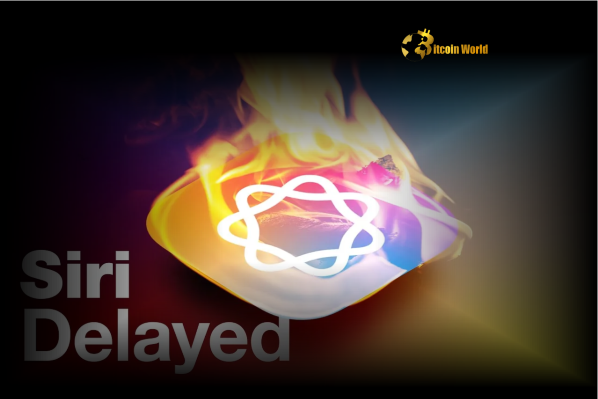BitcoinWorld

Apple AI: Essential Siri Update Delayed, Executives Explain Why
In the fast-paced world of technology, where innovation often feels like a race, even giants face hurdles. This is particularly relevant for those following the crypto space, which thrives on bleeding-edge tech and ambitious roadmaps. Delays are a reality, and understanding why they happen, even at companies like Apple, offers valuable perspective on the complexities of Tech Innovation and AI Development. Recently, Apple executives shed light on why the highly anticipated Siri Update, powered by new Artificial Intelligence capabilities and previewed at WWDC 24, won’t ship as initially hoped this year, pushing its full rollout to 2026.
Why Was the Apple AI Siri Update Delayed?
Following their Worldwide Developers Conference, Apple leaders addressed questions about the absence of the fully personalized, AI-driven Siri demonstrated previously. Contrary to speculation labeling the demo as ‘demoware’ or ‘vaporware,’ senior vice president of software engineering Craig Federighi and senior vice president of worldwide marketing Greg Joswiak offered clear explanations rooted in the realities of bringing complex new technology to market.
Key reasons for the delay:
- The demonstrated version (Architecture v1) was functional but not deemed ready for mass shipment.
- Apple realized that meeting customer expectations required transitioning to a more advanced architecture (v2).
- The v1 software, while real, had an “error rate that we felt was unacceptable” for a broad release.
- Apple sees AI as a “long-term transformational wave” and is prioritizing quality and the right features over being the first to market.
Federighi stressed that the demo was indeed based on “real working software with a real large language model with real semantic search,” pushing back against the idea that it was merely a non-functional mockup.
Artificial Intelligence: Apple’s Unique Approach
While many companies are focused on building standalone chatbots to rival models like ChatGPT, Apple executives reiterated that their vision for Artificial Intelligence is fundamentally different. Their goal isn’t to create a dedicated chat interface users go to for tasks, but rather to deeply integrate intelligence across all their platforms and operating systems.
Federighi explained, “This wasn’t about us building a chatbot… That was never our goal.” Instead, Apple aims for intelligence that is “meet you where you are” – seamlessly assisting users within their existing workflows and apps.
This strategy involves:
- Infusing AI capabilities directly into core OS functions.
- Enabling personalized and contextual assistance via the updated Siri.
- Providing developers with tools to leverage Apple’s foundation models for building more intelligent third-party applications.
This deep integration contrasts with a standalone chatbot model and requires significant foundational work across the entire ecosystem, contributing to the complexity of the AI Development process.
Siri Update: The Path to 2026
The executives confirmed that the full realization of the new Siri Update is now targeted for 2026. This timeline reflects the decision to pivot from the initially demonstrated v1 architecture to the more robust v2, which they believe is necessary to deliver the level of performance and reliability Apple users expect. While the initial plan might have been to ship components sooner, the commitment to a higher standard necessitated revising the schedule.
This situation highlights a common challenge in Tech Innovation: initial prototypes and demos, while functional, often reveal the need for more fundamental architectural changes to scale and meet real-world demands. The decision to delay, while potentially disappointing in the short term, underscores a focus on long-term product quality and user experience over rushing an incomplete solution to market.
Lessons from AI Development Challenges
The experience with the Apple AI powered Siri offers valuable insights applicable beyond Cupertino, particularly in fast-moving sectors like cryptocurrency and blockchain, where ambitious technological goals are common. It demonstrates that:
- Complex AI Development is inherently challenging and timelines can shift.
- Demos represent a snapshot in time and don’t guarantee immediate product readiness.
- Prioritizing a quality user experience often requires difficult decisions, including delays.
- Long-term vision is crucial; rushing incomplete tech can damage reputation and user trust.
For builders and investors in the crypto space, understanding these realities of tech development is vital. It encourages a more nuanced view of project roadmaps and the inherent risks and complexities involved in pioneering new technologies.
Concluding Thoughts on Apple AI and the Siri Update
Apple executives have been transparent about the reasons behind the delay of the full Siri Update, emphasizing that it wasn’t due to the technology being fake or non-functional, but rather a strategic decision based on achieving an acceptable level of quality and performance. Their vision for Apple AI is focused on deep integration across the ecosystem rather than competing in the chatbot arena. While the wait for the most advanced features of the new Siri is extended to 2026, the company maintains its commitment to delivering a transformative Artificial Intelligence experience built on a solid foundation.
To learn more about the latest AI Development trends and their impact on the tech landscape, explore our article on key developments shaping AI features.
This post Apple AI: Essential Siri Update Delayed, Executives Explain Why first appeared on BitcoinWorld and is written by Editorial Team




